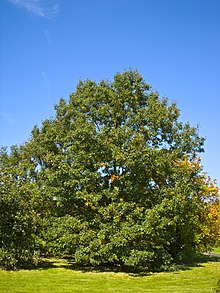Eastern Black Oak
| Black oak | |
|---|---|
 |
|
| Scientific classification | |
| Kingdom: | Plantae |
| (unranked): | Angiosperms |
| (unranked): | Eudicots |
| (unranked): | Rosids |
| Order: | Fagales |
| Family: | Fagaceae |
| Genus: | Quercus |
| Section: | Lobatae |
| Species: | Q. velutina |
| Binomial name | |
|
Quercus velutina Lam. 1785 not Lindl. ex Wallich 1831 nor L'Hér. ex A. DC. 1864 |
|
 |
|
| Synonyms | |
|
List
|
|
Quercus velutina, the eastern black oak or more commonly known as simply black oak, is a species in the red oak (Quercus sect. Lobatae) group of oaks. It is widespread in eastern and central North America, found in all the coastal states from Maine to Texas, inland as far as Ontario, Minnesota, Nebraska, Kansas, Oklahoma, and eastern Texas.
Quercus velutina was previously known as yellow oak due to the yellow pigment in its inner bark, however nowadays this name is usually reserved for Chinkapin oak. It is a close relative of the western black oak (Quercus kelloggii) found in western North America.
In the northern part of its range, black oak is a relatively small tree, reaching a height of 20–25 m (66–82 ft) and a diameter of 90 cm (35 in), but it grows larger in the south and center of its range, where heights of up to 42 m (138 ft) are known. Black oak is well known to readily hybridize with other members of the red oak (Quercus sect. Lobatae) group of oaks being one parent in at least a dozen different named hybrids.
The leaves of the black oak are alternately arranged on the twig and are 10–20 cm (3.9–7.9 in) long with 5–7 bristle tipped lobes separated by deep U-shaped notches. The upper surface of the leaf is a shiny deep green, the lower is yellowish-brown. There are also stellate hairs on the underside of the leaf that grow in clumps.
The inner bark of the black oak contains a yellow pigment called quercitron, which was sold commercially in Europe until the 1940s.
Key Characteristics:
Sun leaves have very deep u-shaped sinuses.
The buds are velvety and covered in white hair.
The fruits or acorns of the black oak are medium-sized and broadly rounded. The cap is large and covers almost half of the nut.
...
Wikipedia
